I have a three dimensional array of points. I need to plot them on a 2D [x,z] grid, where every line is based on the value of Y inside a range. es. the first line is made by points with 0 < y < 1, the second with 1 < y < 2, etc..
I can plot points just fine using this script(to have a better looking graph i'm also changing the color for every set of point by moving inside an rgb triplet). set is the range of the line (in my case Y is time and i need to plot every 0.1 seconds). i is the index for my array of points.
w= 0;
yend = 100;
set = 0.1;
numberOfColors = 1/2*(Yinterval)*(1/set);
incrementOfColor = 1/numberOfColors;
red = 0;
green = 0;
blue = 1;
color=[red green blue];
while w < yend
while y(i)>w&&y(i)<w+set
figure(1)
hold on
plot(x(i),z(i),'.','Color',color);
hold on
i=i+1;
end
w=w+set;
if red < 1-incrementOfColor && blue > 0
red = red + incrementOfColor;
blue = blue - incrementOfColor;
end
if red > incrementOfColor && blue < incrementOfColor
red = red-incrementOfColor;
green = green + incrementOfColor;
blue = 0;
end
color = [red green blue];
end
And this is the result: https://i.stack.imgur.com/1R4IN.png When there's too much data the plot becomes cumbersome to read, and with too little data isolated points don't really tell much. I've tried converting the points inside a "set" interval into an array but it really didn't work out:
while w < yend
while y(i)>w&&y(i)<w+set
vX(a,:)=x(i);
vZ(a,:)=z(i);
i=i+1;
a=a+1;
end
figure(2)
hold on
plot(vX,vZ,'-','Color',color);
Gave this result: imgur.com/S7OasUn.jpg
Is my conversion wrong or arrays are just not the proper way to handle this? If so, what should I use?
I'm rather new to matlab so if this is really obvious or i'm asking something in the wrong way, please excuse me.
edit:
This is the result i want to achieve:
imgur.com/jPZTO8E.png
and it was obtained with Origin's contour profile tool.
I guess you mean this with functional example:
myPoints[i]:
i=0, x = 1, y= 0.03, z = 1
i=1, x = 2, y= 0.06, z = 3
i=2, x = 2.5, y = 0.09, z = 4
i=3, x = 1.2, y = 1.01, z = 3.1
i=4, x = 1.3, y = 1.04, z = 1.1
i=5, x = 1.2, y = 1.06, z = 2.5
i=6, x = 2, y = 1.09, z = 3.1
i=7, x = 1.2, y = 2.02, z = 3.1
etc..
i want the points i 0,1,2 plotted as one line, i 3,4,5 as another line and i 7 etc.. plotted as a third line. In my data i have a lot of points.
this is one example of the data i'm using. https://drive.google.com/file/d/0B9GHAkIYepQcRXdBdy03dFJtT1k/view?usp=sharing where:
x = myPoints(:,1);
y = myPoints(:,2);
z = myPoints(:,3);
In this specific case, i only care about the points with y value between 85.85 and 90.85, and i want to "place an edge" (?) every 0.1
x = myPoints(:,1);
y = myPoints(:,2);
z = myPoints(:,3);
ymin = 85.85;
ymax = 90.85;
set = 0.1;
nbins = (ymax-ymin)/set;
binedge = linspace(ymin, ymax, (nbins + 1));
